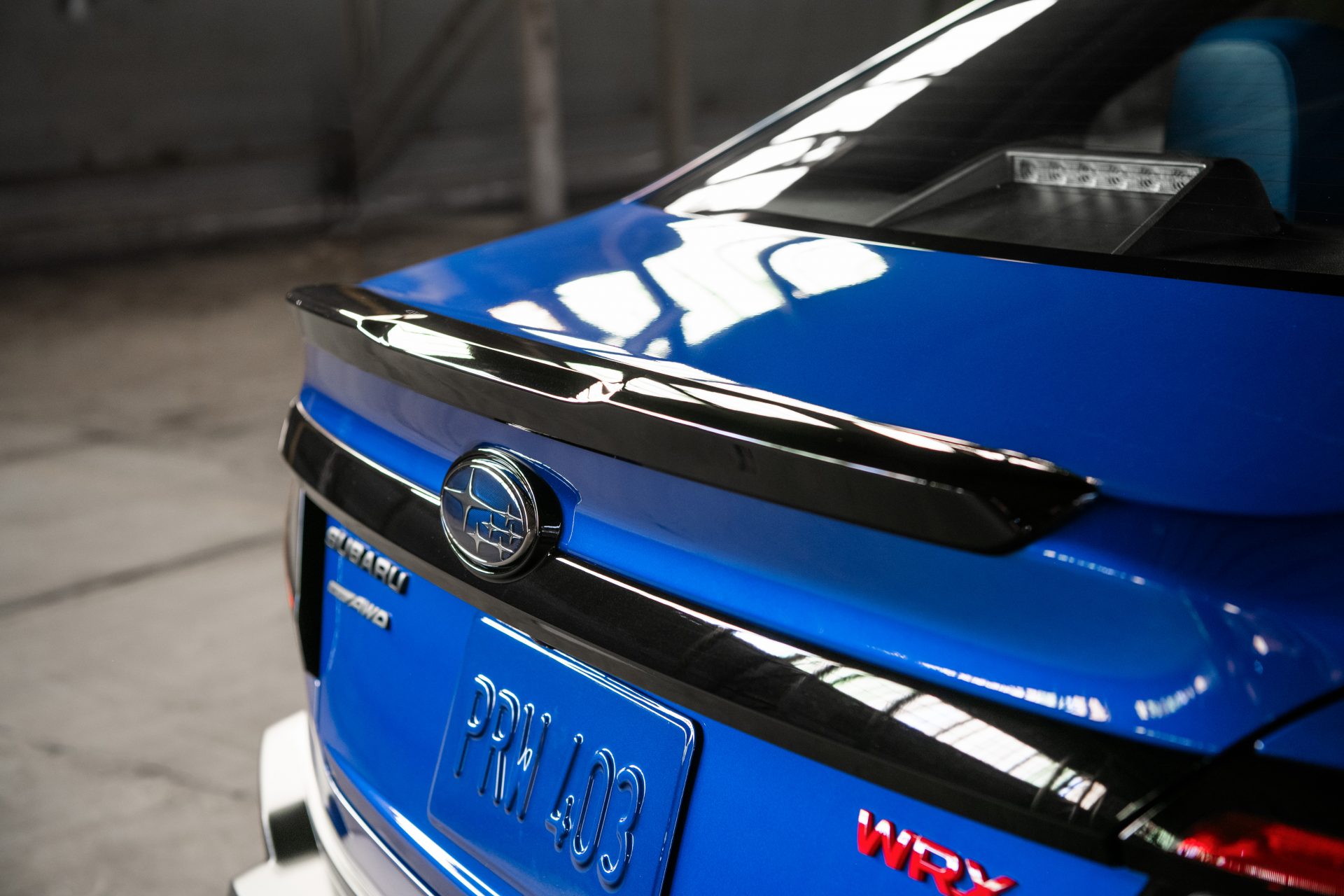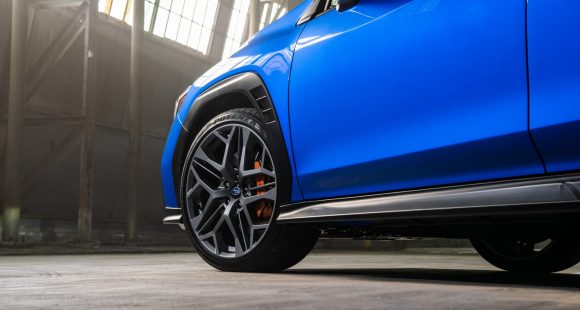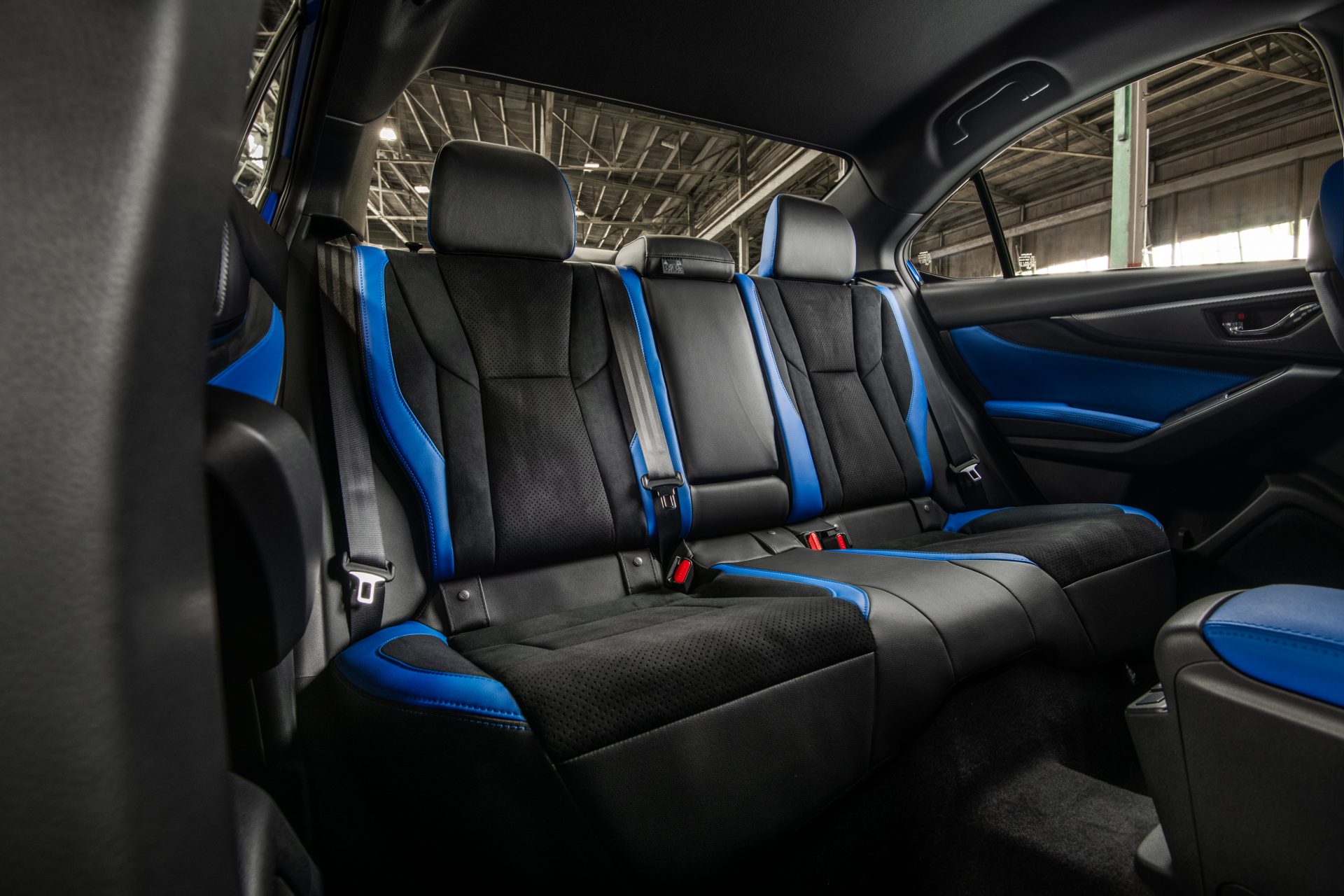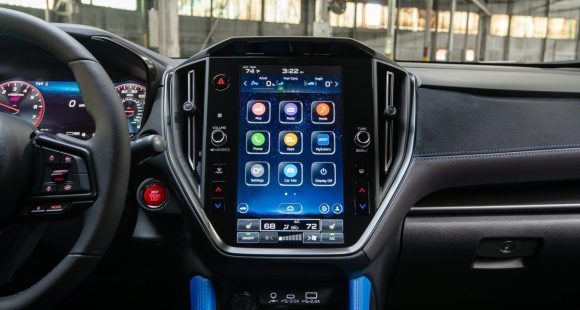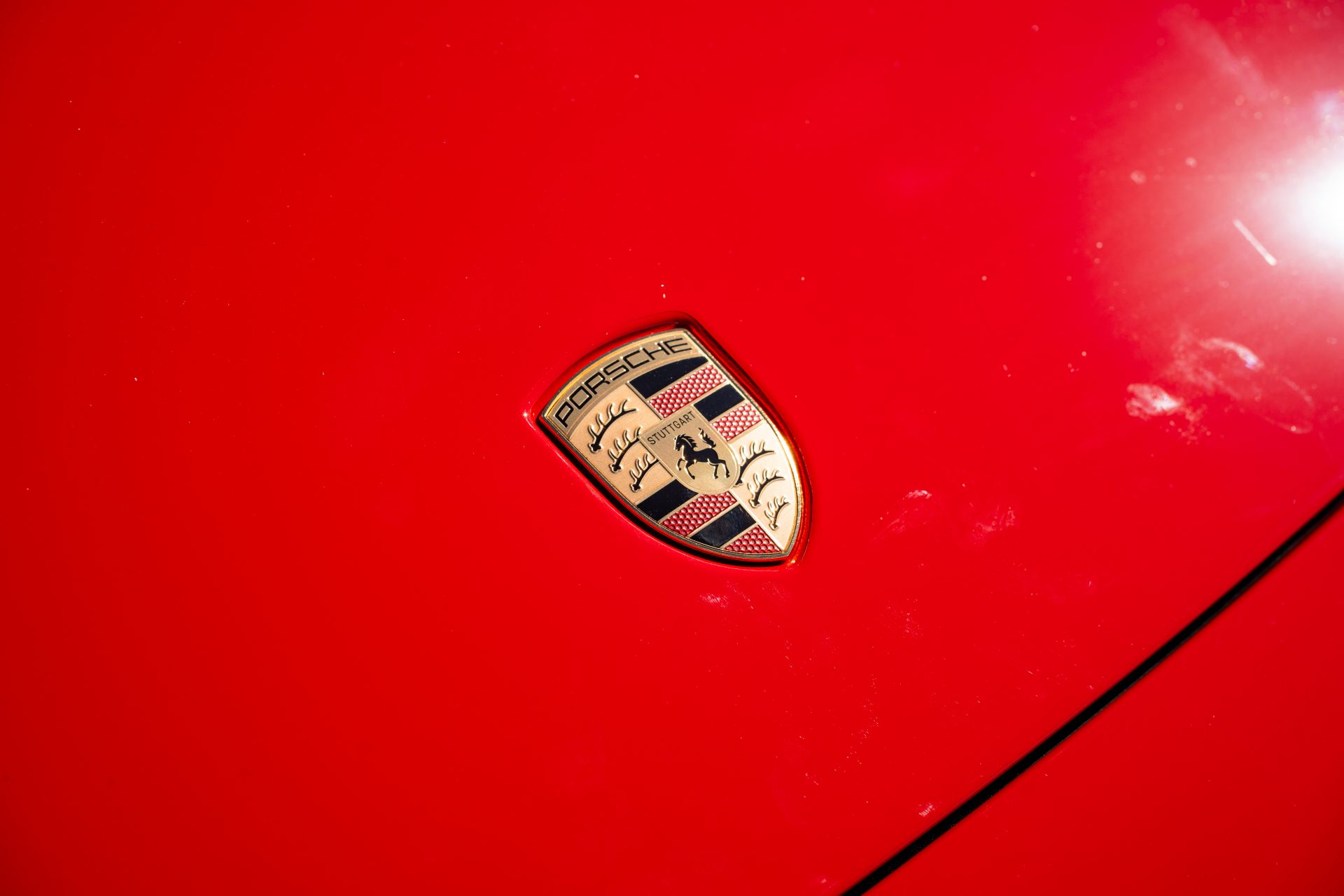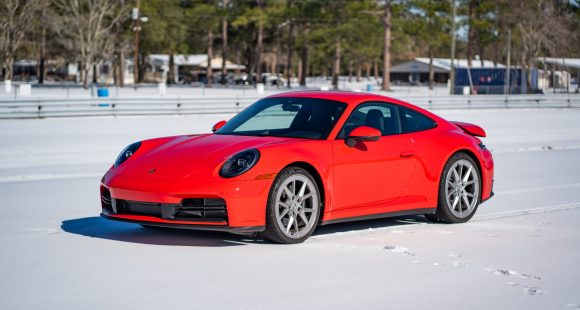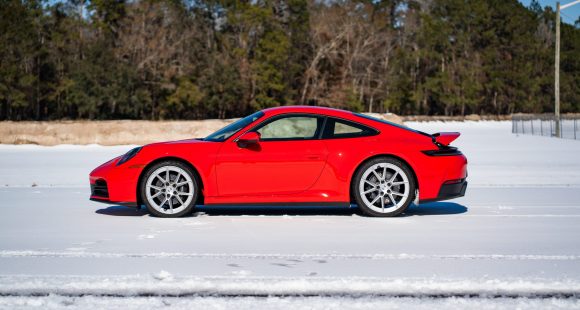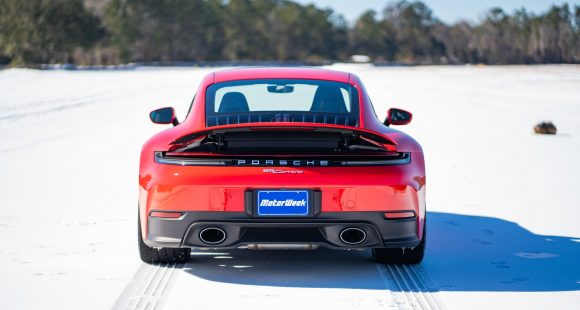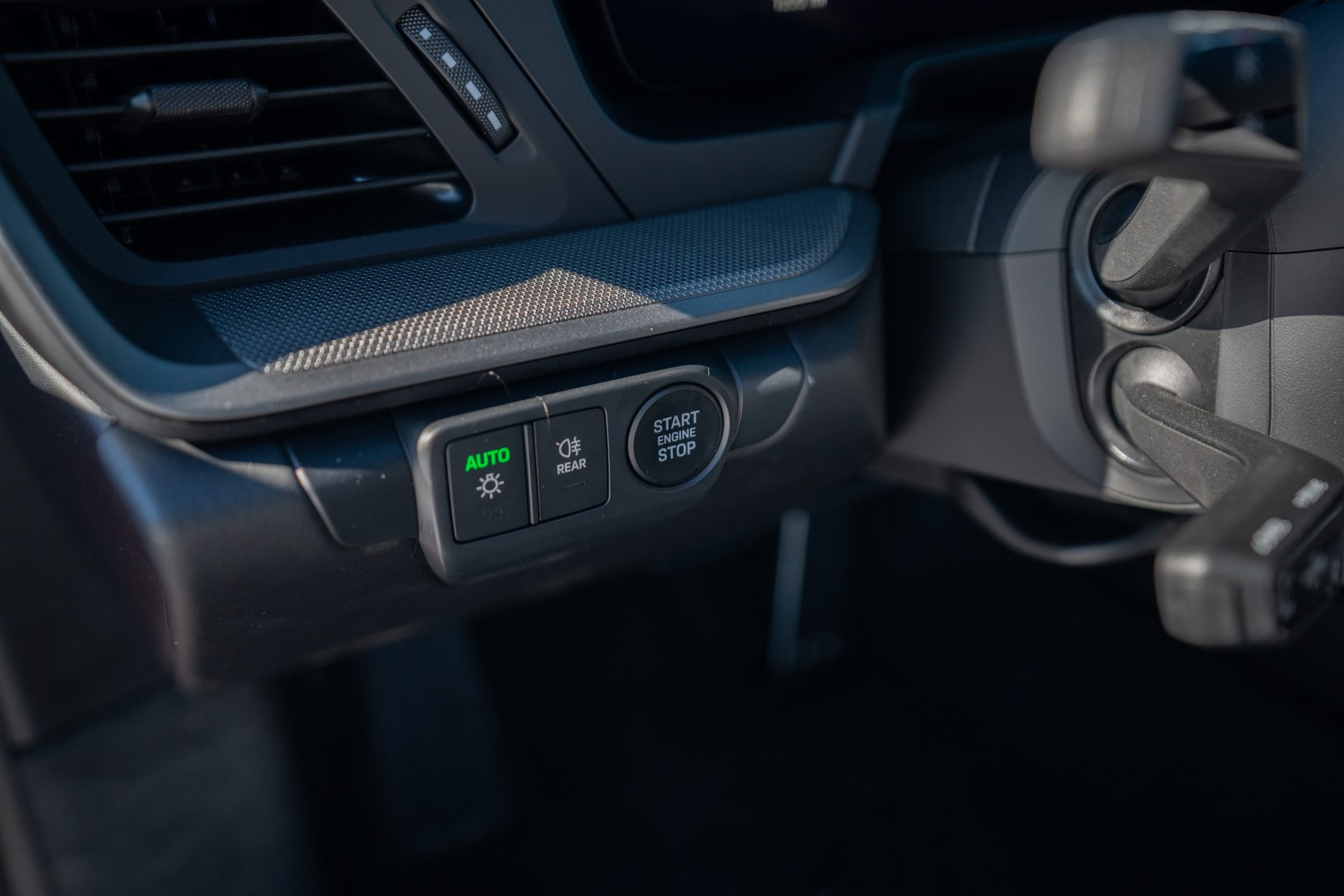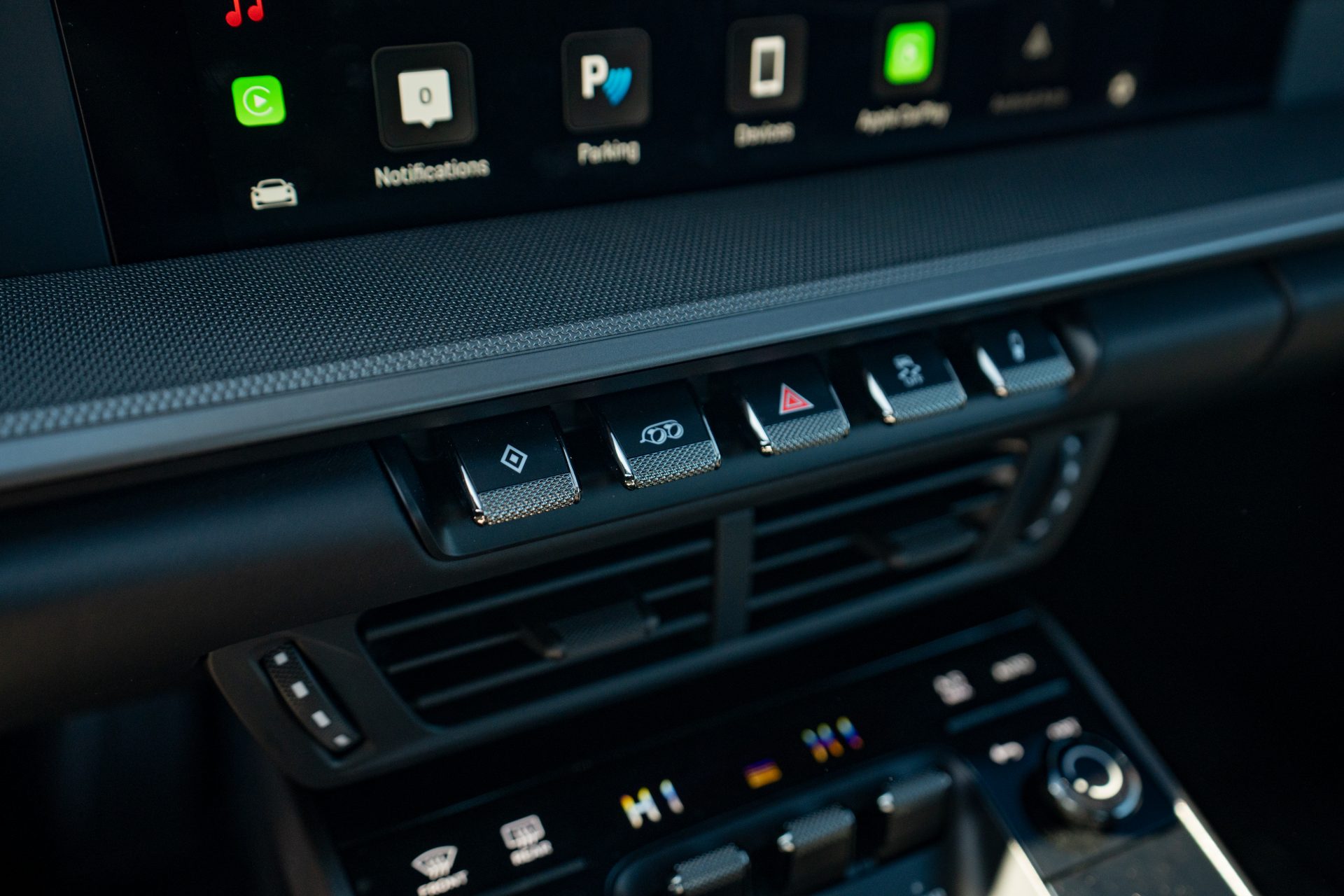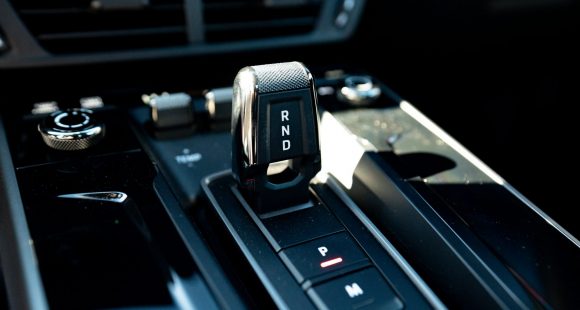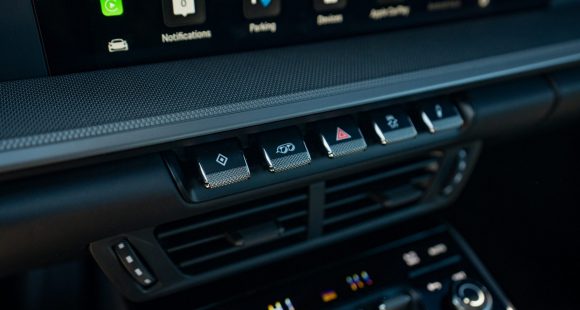2015 Subaru WRX STI
The all-new Subaru WRX just rode home with our 2014 Drivers’ Choice Award for best sport sedan. It simply delivered lots of serious thrills for the money. But we knew that the WRX was just a tease until the next WRX STI arrived. Well, it’s here! So, with our hopes flying sky-high, let’s strap in, and see if the next hot Subaru can make our smiles even wider.
Going down the spec sheet, the 2015 Subaru WRX STI checks all the right boxes for purists: rally grade suspension…a six speed manual transmission…over 300 horsepower…check, check, AND check. Yet for a vehicle of the STI’s heritage, predicated on back-to-basics, old school fun, this latest model does benefit from some new-age technologies, despite changing little else from previous generations…
 Returning is the BOXER horizontally opposed turbo flat 4; 2.5 liters worth, and rated at 305 horsepower and 290 lb-ft of torque. Indeed it is the same engine, and the same output, that the STI faithful already know. And it’s mated to the very same six speed manual transmission, as well. Slight improvements for 20-15 reduce vibrations, and make shifts smoother between low gears.
Returning is the BOXER horizontally opposed turbo flat 4; 2.5 liters worth, and rated at 305 horsepower and 290 lb-ft of torque. Indeed it is the same engine, and the same output, that the STI faithful already know. And it’s mated to the very same six speed manual transmission, as well. Slight improvements for 20-15 reduce vibrations, and make shifts smoother between low gears.
Symmetrical All-Wheel Drive is naturally standard, as is the Driver Control Center Differential, which allows for mechanical and electronic control of the center diff through various settings. All this, combined with the helical limited–slip front diff, and the TORSEN limited-slip rear diff, basically translates to: GRIP. And lots of it.
New this year is Active Torque Vectoring, which works with the stability and traction control systems to apply a bit of braking while cornering. So what better place to experience all this, than at our test track?
Off the line power was easy to find, with a more manageable clutch than in our 2011 test. We just hooked up and flew to 60 in 4.7 seconds. Seven tenths quicker than the WRX. Then our STI punched through the full ¼ mile in 13.2 seconds at 104 miles per hour.
 Where Subaru says they improved the STI the most is in handling. And indeed, through the cones it really comes alive. The added rigidly and a thoroughly retuned suspension, while a little more solid than before during commutes, really takes to tight switchbacks. The quickened steering ratio, now 13.0:1, adds precision and great feedback.
Where Subaru says they improved the STI the most is in handling. And indeed, through the cones it really comes alive. The added rigidly and a thoroughly retuned suspension, while a little more solid than before during commutes, really takes to tight switchbacks. The quickened steering ratio, now 13.0:1, adds precision and great feedback.
Getting to high speeds is easy in the STI, and luckily, so is slowing it down; taking a scant 108 feet from 60.
As with the standard WRX, the STI distances itself from the Impreza sedan on which it is still technically based. Wheelbase is also stretched one inch over the last STI, to 104.3 inches, and the A pillars and windshield are significantly more raked, offering both a more swept look and better visibility.
But what’s an STI without the wing?! It’s here, in full force, to augment the WRX’s hood scoop up front, and quad exhaust in the back. Our Limited tester’s 18 inch BBS forged alloy wheels came wrapped in 245/40 summer performance tires. But our inner “Mr. T” wishes we could have the Launch Edition’s gold wheels, and its WR Blue Pearl paint, and we pity the fool who doesn’t grab one of the only 1,000 in production. But we digress…
 Hop inside, and you’ll find things are also very similar to the standard WRX including racer red gauge accents, a 4.3 inch dash top screen, faux carbon fiber trim, and flat-bottom steering wheel that feels great. One plus, the improved “STI” embroidered seats do offer better grip, and we loved the STI-exclusive short throw shifter.
Hop inside, and you’ll find things are also very similar to the standard WRX including racer red gauge accents, a 4.3 inch dash top screen, faux carbon fiber trim, and flat-bottom steering wheel that feels great. One plus, the improved “STI” embroidered seats do offer better grip, and we loved the STI-exclusive short throw shifter.
Government Fuel Economy ratings, are 17 City, 23 Highway, and 19 Combined. Even driving like we think owners will, our test loop of 23.4 on premium was better than expected.
Even better news is that STI base pricing starts at a reasonable $35,290. Limited trim goes for $39,290, with our test car adding a $1,500 NAV and Keyless Access option. It’s a little more “buck” over the WRX, but you do get a lot more “bang” for it.
Now it may seem to casual observers that the STI got left behind, as Subaru has been doling out the major overhauls everywhere else in their lineup. But while we always love something that’s “all-new”, there’s a certain charm to holding on to some of the “tried-and-true”. The STI has always been a showcase of exceptional performance with an accessible price; which is exactly why we love the 2015 Subaru WRX STI even more.
Specifications
- Engine: 2.5 liters
- Horsepower: 305
- Torque: 290 lb-ft.
- 0-60 mph: 4.7 seconds
- 1/4 mile: 13.2 seconds @ 104 mph
- EPA: 17 mpg city/ 23 mpg highway
2025 Subaru WRX tS
Subaru’s “World Rally eXperimental” Gets Tecnica-Tuned Tech
Building on its global rally heritage, WRX has been a standalone Subaru nameplate, marketed separately from garden variety Impreza, for two generations now. And while the current WRX still lacks the full STI treatment, this WRX tS serves up some of that high-performance spice we’ve been longing for.
Before we go flat out into our Track Test of this 2025 Subaru WRX tS, lets open the Subaru dictionary so we’re all on the same page. “tS” stands for “tuned by STI;” and “STI” is an acronym for “Subaru Tecnica International,” the brand’s high-performance sub-group best known for upgrading the WRX— oh, that stands for “World Rally eXperimental,” in case you didn’t know.
All that said, STI has been largely dormant for this WRX generation, but this tS sprinkles more of their engineering magic into the mix. No, that doesn’t mean extra power, but does mean significant chassis-related improvements.
First, electronically controlled dampers, adjustable through the 11.6-inch tablet-style infotainment screen. That meant a softer “comfort” mode on the 10+ hour commute to and from Savannah’s Roebling Road Raceway. But once we were there, it was the firmer “Sport+” setting all the way, heightening response from the WRX’s throttle and already quick dual-pinion power steering system. There’s still some body roll for rally-esque weight transfer, but it’s well sorted and provides the “toss-ability” you want in a WRX.
Though if you do autocross your tS, which we implore you to do, you might feel the six-piston front, two-piston rear Brembo brakes first. The bite is strong, giving good rotation in the corners and plenty of “halt” for this 3,400 lb. compact with minimal fade, keeping us on track all week…until some unfortunate winter weather passed overhead. No worries here, as Subaru’s Symmetrical All-Wheel-Drive system got us to the track for some powdered deserts: Frosted donuts served up Michelin style, a set of winter tires different from the grippy Bridgestone Potenza S007 rubber the tS typically rides on. Some prior hot laps of California’s Sonoma Raceway gave credence to those Bridgestones, and showed us what this hot-compact can do in ideal conditions.
It’s well sorted and provides the “toss-ability” you want in a WRX.
Other tS enhancements are cabin-based, namely these beautiful blue Recaros. Most of our staff appreciated their moderately-aggressive bolstering on both street and track. And they’re even heated, too. Another tS-only appointment is this 12.3-inch digital gauge display. It mimics the standard analog gauges with some additional info, but can switch to a navigation mode for more convenient route guidance.
We do wish our tS came in the new Galaxy Purple or the trademark World Rally Blue, but this Crystal White paint wasn’t too shabby, contrasting its Cherry Blossom Red badging and blacked-out lip spoiler. Otherwise, the tS is like any other WRX, down to the hood scoop funneling air to the top-mounted intercooler.
Underneath is the same turbocharged 2.4-liter flat-four in all other trims, boxing at 271 horsepower and 258 lb-ft of torque. The freak winter weather stopped straight-line testing, but a 0-60 time estimate of 5.5 seconds is about as spry as you realistically need, pulling strong through most of the tach; though the 6,000 RPM redline required attentive shifting of the six-speed box, which the tS comes exclusively with. The throws are precise, if a little long, and the clutch is wonderfully weighted.
With discontinuation of the Base trim, pricing for the WRX now starts with Premium at $36,920. The tS is at the top of the lineup with the automatic-only GT, both starting at $46,875. All WRXs continue to be made in Gunma, Japan.
If you’re an enthusiast itching to do the tuning yourself, perhaps the 2025 Subaru WRX tS is not for you. But if you want a plug-and-play experience, this is it. While it won’t exactly bestow the loose-cannon, top-level driving skills exhibited by famous WRC drivers upon you, the tS moves this WRX’s game in a direction we’ve so desperately wanted Subaru to take.
Specifications
As Tested
- Engine: 2.4-liter flat-four
- Tranmission: 6-speed manual
- Horsepower: 271
- Torque: 258 lb-ft
2025 Porsche 911 Carrera
Ever Evolving 911 Reaches New Heights
The Porsche 911 has existed for 60 years now! Amazing! And, you could argue that major changes over all those years have been relatively few, as constant incremental improvement is more the way that Porsche does business. With that in mind, let’s hit the track in the latest 911 and see what constant improvement means for 2025.
We’ve driven so many 911s here at MotorWeek, each seemingly more special than the last, so it’s a bit refreshing to be ripping around Savannah’s Roebling Road Raceway in a 2025 Porsche 911 that’s about as close as you can get to base these days. And the fact that it’s just as fun as all those exclusive pieces says a lot about how far the 911 has come. Perhaps it also speaks to how much a base 911 will set you back today as well; more on that later.
For now, we’re just thinking about the next apex, holding steady throttle as we approach, and getting on it way sooner than you’d expect without upsetting anything, as the 911 rockets off the corner thanks to tremendous grip and a PDK trans that finds the perfect gear before we even gave it a thought. Even with very cold track temps, we never struggled for grip or battled any wheelspin coming off of corners. And trying to land it in that perfect spot in braking zones is easy with strong brake performance that was predictable and consistent lap after lap; no wandering, and great feedback too.
Yes, even the standard 911 is near pure perfection on a racetrack. It gives you all the right feedback, stays incredibly flat through corners, makes you always feel totally in control, and again is just plain fun. Unless you’re chasing lap times, there’s really no need to head further up the 911 tree. Though it is worth noting the few upgrades that were on our Carrera did help the situation a little. The 20- and 21-inch Carrera S wheels enabled plenty of grip from the 305 Pirelli P Zero tires, the Sport Chrono Package allows 0-60 sprints of 3.7 seconds, an extended range fuel tank meant we could lap all day without having to fill up, and the fantastic Sport Seats provided great support and better comfort than we remember experiencing in a 911. The Sport Exhaust system didn’t add anything to performance, but made things sound a whole lot better, and the oval silver tips look great too.
We never struggled for grip or battled any wheel spin coming off of corners.
Our track time got cut short thanks to a rare snowstorm in Coastal Georgia, but the white stuff and blue sky made the perfect backdrop for our Guards Red Carrera. Exterior tweaks for what is officially the 992.2 include a reshaped front fascia with improved aerodynamics. All front lighting is now contained within the Matrix Design LED headlight housing. The rear fascia has also been smoothed out, the license plate moved higher, and Porsche 3D block lettering spelled out across the back beneath the active rear spoiler and new decklid grille.
Even without Turbo in the name, the standard 911 engine is indeed a turbo these days, a 3.0-liter flat-six twin-turbo delivering 388 horsepower and 331 lb-ft strictly to the rear wheels in the Carrera Coupe.
Inside the cabin, the 911 continues its slow crawl towards the modern, now including a 12.6-inch fully digital gauge display and a start button located on the left side of the steering wheel, with drive modes easily accessible on the wheel itself. In another no brainer move, Porsche now makes the rear seat a no cost option, so you can choose if you want it or not.
Government Fuel Economy Ratings are 18 City, 25 Highway, and 21 Combined. That’s only slightly worse than average for the Energy Impact Score; 14.2 barrels of annual oil consumption with 7.0 tons of CO2 emissions.
The good news is this 911 had the fewest number of options of any Porsche that we’ve tested in some time, and it was still plenty awesome; the bad news is, a base Porsche 911 Carrera Coupe now starts at $122,095.
But can you really put value on “the force,” this mythical power that Porsche seems to have, that somehow turns average drivers into great ones? It’s useless to resist as far as we’re concerned, as it only gets better with the 2025 Porsche 911 Carrera.
Specifications
As Tested
- Engine: 3.0-liter twin-turbo flat-6
- Transmission: 8-speed PDK
- Horsepower: 388
- Torque: 331 lb-ft















